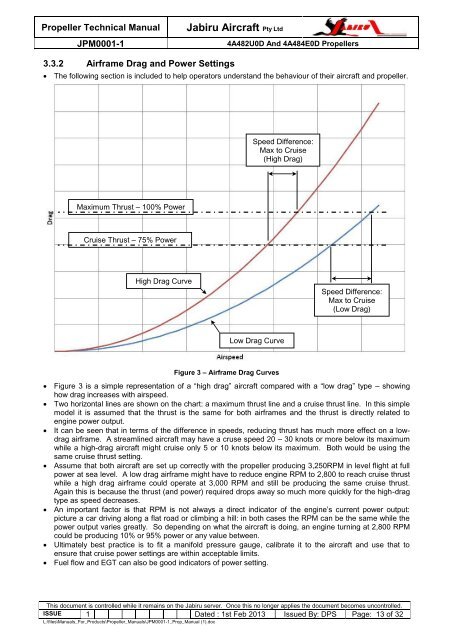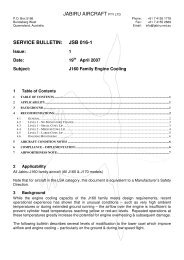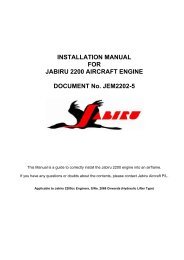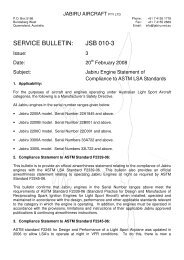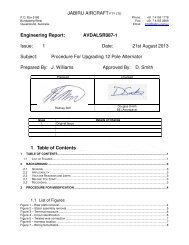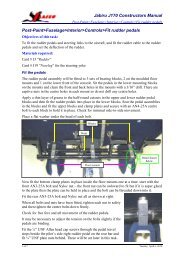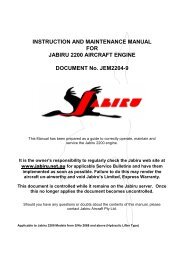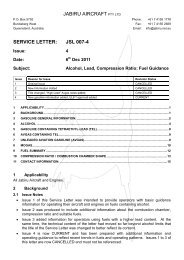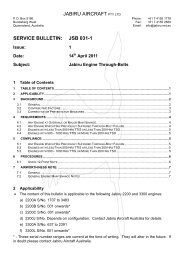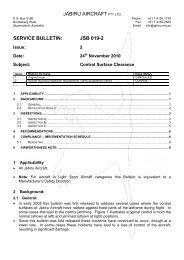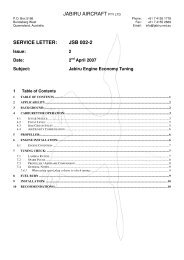Propeller Technical Manual - Jabiru
Propeller Technical Manual - Jabiru
Propeller Technical Manual - Jabiru
Create successful ePaper yourself
Turn your PDF publications into a flip-book with our unique Google optimized e-Paper software.
<strong>Propeller</strong> <strong>Technical</strong> <strong>Manual</strong><br />
JPM0001-1<br />
<strong>Jabiru</strong> Aircraft Pty Ltd<br />
4A482U0D And 4A484E0D <strong>Propeller</strong>s<br />
3.3.2 Airframe Drag and Power Settings<br />
The following section is included to help operators understand the behaviour of their aircraft and propeller.<br />
Speed Difference:<br />
Max to Cruise<br />
(High Drag)<br />
Maximum Thrust – 100% Power<br />
Cruise Thrust – 75% Power<br />
High Drag Curve<br />
Speed Difference:<br />
Max to Cruise<br />
(Low Drag)<br />
Low Drag Curve<br />
Figure 3 – Airframe Drag Curves<br />
Figure 3 is a simple representation of a “high drag” aircraft compared with a “low drag” type – showing<br />
how drag increases with airspeed.<br />
Two horizontal lines are shown on the chart: a maximum thrust line and a cruise thrust line. In this simple<br />
model it is assumed that the thrust is the same for both airframes and the thrust is directly related to<br />
engine power output.<br />
It can be seen that in terms of the difference in speeds, reducing thrust has much more effect on a lowdrag<br />
airframe. A streamlined aircraft may have a cruse speed 20 – 30 knots or more below its maximum<br />
while a high-drag aircraft might cruise only 5 or 10 knots below its maximum. Both would be using the<br />
same cruise thrust setting.<br />
Assume that both aircraft are set up correctly with the propeller producing 3,250RPM in level flight at full<br />
power at sea level. A low drag airframe might have to reduce engine RPM to 2,800 to reach cruise thrust<br />
while a high drag airframe could operate at 3,000 RPM and still be producing the same cruise thrust.<br />
Again this is because the thrust (and power) required drops away so much more quickly for the high-drag<br />
type as speed decreases.<br />
An important factor is that RPM is not always a direct indicator of the engine’s current power output:<br />
picture a car driving along a flat road or climbing a hill: in both cases the RPM can be the same while the<br />
power output varies greatly. So depending on what the aircraft is doing, an engine turning at 2,800 RPM<br />
could be producing 10% or 95% power or any value between.<br />
Ultimately best practice is to fit a manifold pressure gauge, calibrate it to the aircraft and use that to<br />
ensure that cruise power settings are within acceptable limits.<br />
Fuel flow and EGT can also be good indicators of power setting.<br />
This document is controlled while it remains on the <strong>Jabiru</strong> server. Once this no longer applies the document becomes uncontrolled.<br />
ISSUE 1 Dated : 1st Feb 2013 Issued By: DPS Page: 13 of 32<br />
L:\files\<strong>Manual</strong>s_For_Products\<strong>Propeller</strong>_<strong>Manual</strong>s\JPM0001-1_Prop_<strong>Manual</strong> (1).doc


